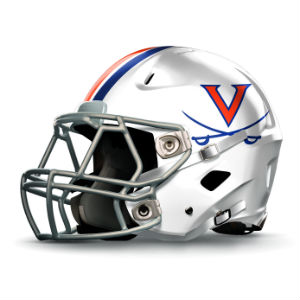
Virginia is third in the ACC in scoring offense (33.2 points per game). Virginia Tech: sixth (31.0 points per game).
Virginia Tech is fourth in scoring defense (22.3 points per game). Virginia: fifth (22.9 points per game).
They’re fourth and fifth in total defense, fourth and fifth in rushing defense, fourth and fifth in passing defense.
UVA QB Bryce Perkins is second in total offense, third in passing yards, fourth in pass efficiency.
Virginia Tech QB Hendon Hooker is 5-0 as a starter.
Both teams come into Black Friday with 8-3 records and three-game winning streaks.
This one’s Ali-Frazier, with the winner getting George Foreman.
***
We could include in the similarities the observation that both are different teams from where they were in Week 1 in August.
Virginia was the defense-first, score-enough-to-win group when it got out to its 4-0 start, but its recent 3-0 run has been about the offense, which is averaging 42.0 points and 476.3 yards per game, while the defense has backslid after losing safety Brenton Nelson and All-America corner Bryce Hall to injury, allowing 28.7 points and 434.3 yards per game.
Virginia Tech wasn’t particularly good on either side of the ball as the Hokies limped out to a 2-2 start, but since Hooker took over as the starter at QB, they’re been … good enough.
Tech is 6-0 in games started by Hooker (including the win over UNC in which he was knocked out in the second quarter).
Looking at the five games that he has played start to finish, you’re talking 37.0 points and 403.2 yards per game of total offense, which, compared to the output in the other six – 26.0 points and 324.0 yards per game – pretty good.
The Tech defense, gashed for 491 yards as recently as the Oct. 19 win over North Carolina, has been stout of late, giving up 204 yards a game over its last three, and not even surrendering a point since the 8:52 mark of the third quarter of the win over Wake three weeks ago.
***
I think you have to attribute at least some of the improvement on defense to the improvement on offense since Hooker was inserted into the lineup.
The Hokies had the ball for 36:09 in the 36-17 win over then-#23 Wake Forest on Nov. 9, and 35:17 in the 28-0 whitewash of Pitt on Nov. 23, a healthy reminder that if you don’t have the ball, you can’t do much with it, if you’re Wake or Pitt.
Hooker’s numbers – 62.7 percent completion rate, 199.8 passing yards per start, 10 TDs, 0 INTs, 179.3 passer rating – would rank him at the top of the ACC, if he had enough pass attempts to qualify for the league lead.
Hooker also adds 45 yards per start on the ground, augmenting a ground game led by 5’9” redshirt junior Deshawn McClease (57.3 yards per game, 4.2 yards per carry) and 5’11” freshman Keshawn King (33.8 yards per game, 4.4 yards per carry).
Offensive coordinator Brad Cornelsen also uses wideouts Tre Turner and Tayvion Robinson in the run game – the two have combined for 29 attempts, and are averaging 11.0 yards per attempt.
So, you’ve got two bruisers who can beat you up inside, and a QB and two wideouts who can get yards on the perimeter.
The receivers are a committee – Turner and Robinson both lead in receptions, each with 26, but you also have to account for Damon Hazelton (23 catches), Hezekiah Grimsley (10 catches) and the tight-end tandem of Dalton Keene (19 catches) and James Mitchell (18 catches).
It’s obvious, from looking through all that, why the Hokies can be hard to defend. They can get yards from a power running game, from jet-sweep action to wideouts, from designed runs by the QB, from the QB scrambling, and when the QB does go to the air, he has four wideouts and two tight ends to account for.
***
On defense, that unit has rounded itself into being a traditional Bud Foster-type defense, which stacks the box to take away the run and get pressure on the quarterback, relying on its corners to take away your wideouts with press coverage.
Tech opponents are gaining just 118.1 yards per game on the ground, fourth in the ACC, and the Hokies have tallied up 35 sacks, third-best in the ACC.
Season-long numbers for Virginia don’t look good in terms of the ground game and preventing sacks (UVA is 13th in the ACC in rushing, at 123.6 yards per game, and has allowed 34 sacks, tied for 11th in the conference).
But of late, the ‘Hoos have been much better – averaging 172.0 yards per game on the ground over their last three games, though opponents still have registered eight sacks in the last three.
The way Virginia attacks Tech, though, isn’t going to be on the ground. Think the game plan at Carolina, in the 38-31 win back on Nov. 2.
UNC coach Mack Brown said afterward that the defensive game plan was to render the UVA offense one-dimensional by stacking the box to take away the run.
Virginia receivers Terrell Jana, Hasise Dubois and Joe Reed consistently won the one-on-one matchups with the Carolina secondary as Bryce Perkins had a 30-for-39, 378-yard, three-touchdown night.
Perkins also broke off a 65-yard touchdown run on a scramble aided by the fact that putting your corners in man coverage on the perimeter makes it hard for them to offer support when the QB breaks contain.
I’d expect Virginia offensive coordinator Robert Anae to take a similar approach with Tech this week that he took with UNC earlier this month.
It was an approach that also worked in the second half of Virginia’s 34-31 OT loss in Blacksburg last November.
After a scoreless first half in which Virginia tried to play conventionally, mixing run and pass, Anae opened things up for Perkins in the second half, and Perkins threw for 216 yards while leading the ‘Hoos on scoring drives of 75, 75, 75 and 85 yards.
It’s kind of like how things are with Tony Bennett’s Pack Line defense. The way you beat the UVA Pack Line is by knocking down threes, because you’re not going to get points in the post or on dribble-drives.
Easier said than done, but if you can knock down your threes, you can win.
The way you can beat Bud Foster’s Tech D is if you have receivers who can beat press coverage and a quarterback who can get them the ball and also be a threat if he has to tuck it down and run.
Again, easier said than done, but if the Virginia O-line can give Perkins even just a sliver of time, you can win.
***
I don’t think the UVA D, banged up as it has been, stops Tech enough to win a 17-14 game.
For UVA to break the million-year losing streak, it’s going to have to be Perkins and the offense putting 30+ on the scoreboard, and the D getting a stop late to preserve it.
I can see why Vegas has Tech as a 2.5-point favorite.
I can also see why the ESPN Football Power Index gives Virginia a 64.6 percent chance to win.
It will come down to who is able to assert their will.
Story by Chris Graham










